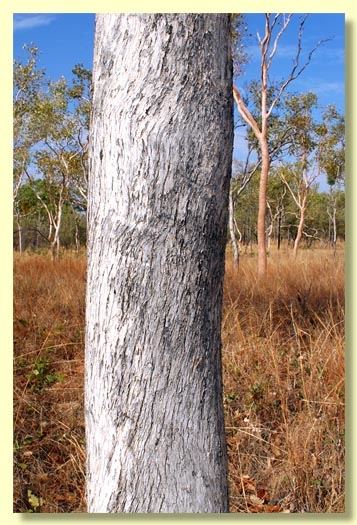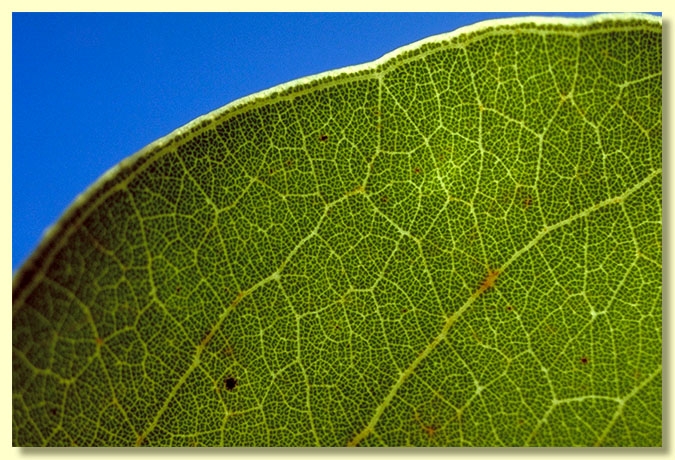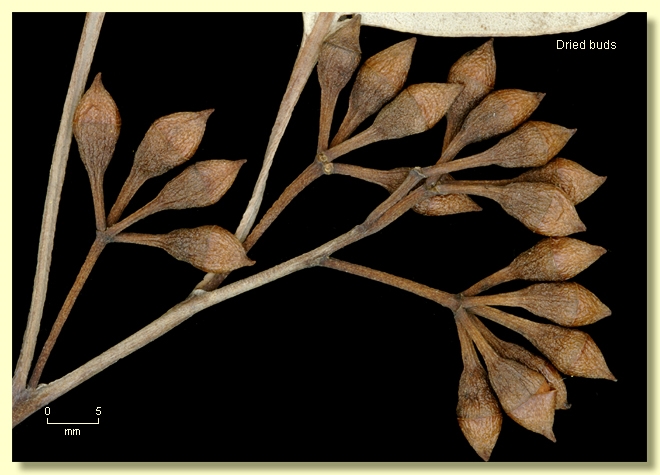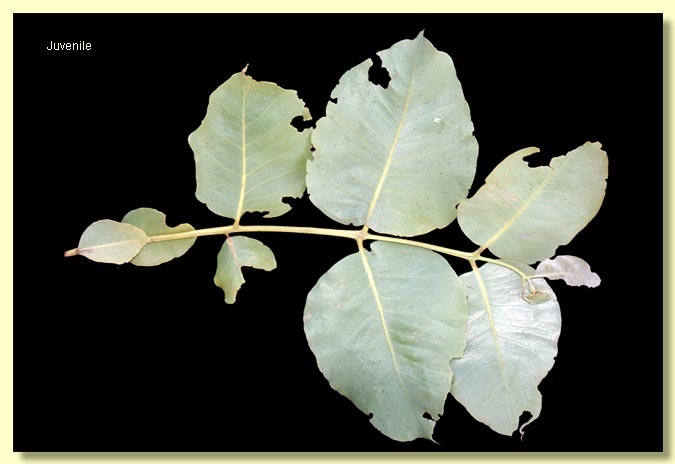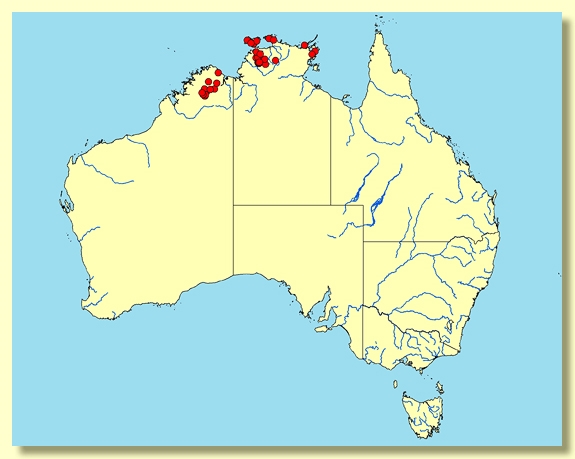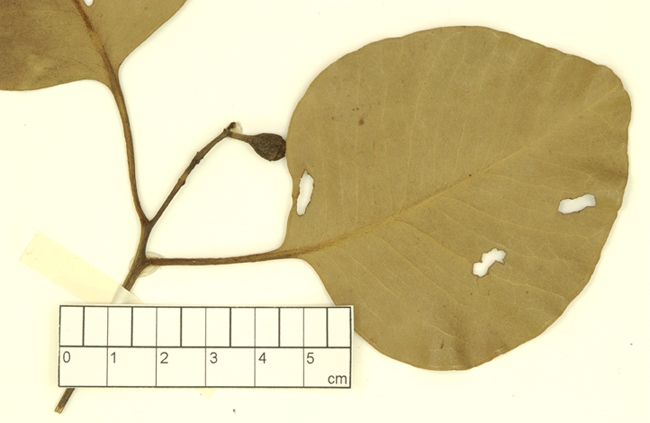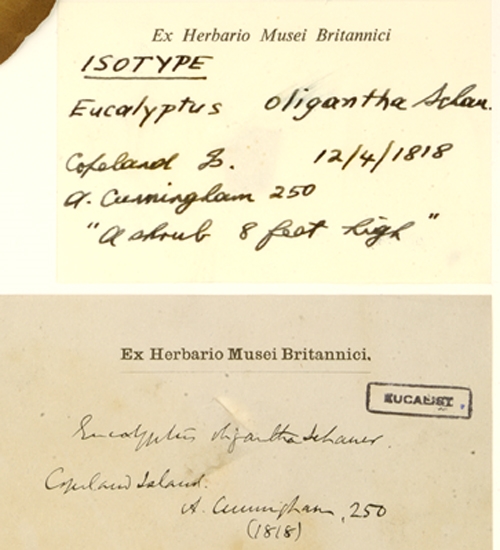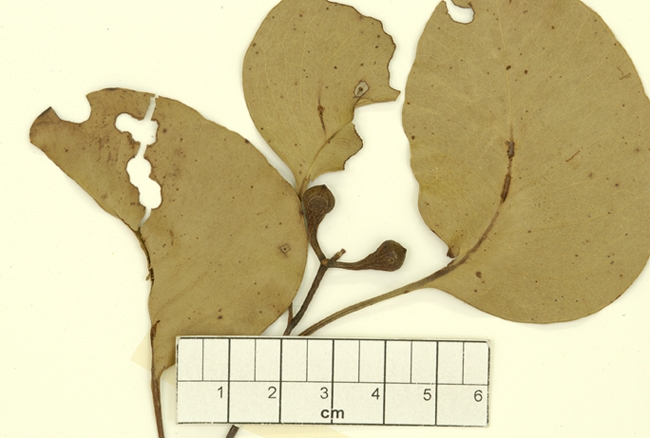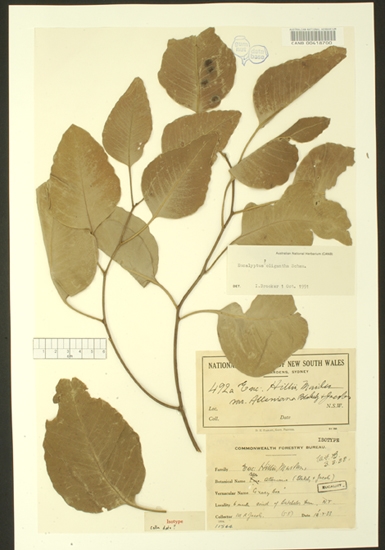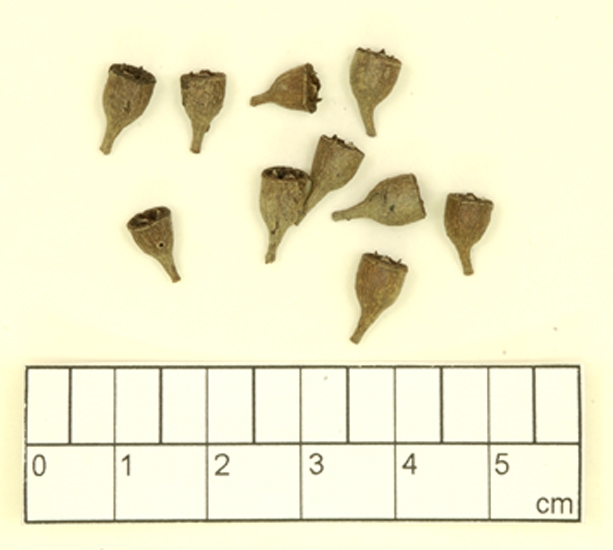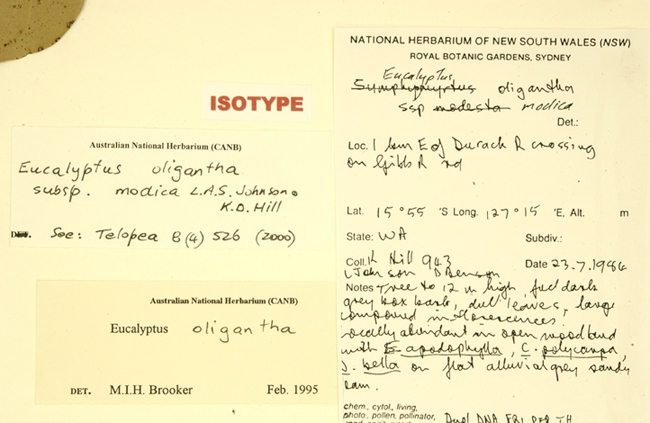Euclid - Online edition
Eucalyptus oligantha
Eucalyptus | Symphyomyrtus | Adnataria | Apicales | Aquilonares | Fortes
Eucalyptus fitzgeraldii Blakely, Key Eucalypts: 239 (1934). T: between Tabletop Mountain and Artesian Range, near Charnley R., Western Australia, Aug. 1905, W.V.Fitzgerald 1353; holo: NSW; iso: BRI, CANB, K, PERTH.
Eucalyptus oligantha subsp. modica L.A.S.Johnson & K.D.Hill, Telopea 8: 526 (2000). T: Western Australia: 1 km E of Durack R. crossing on Gibb River rd, 23 July 1984, K.D.Hill 943, L.A.S.Johnson & D.Benson; holo: NSW; iso: CANB, DNA, PERTH.
Tree to 12 m tall. Forming a lignotuber. Partly to almost completely deciduous in the dry season.
Bark rough throughout, box-type, becoming scaly or tessellated in part, grey to greyish white or very pale brown.
Branchlets lack oil glands in the pith; non-glaucous.
Juvenile growth (coppice or field seedlings to 50 cm): stems rounded or slightly square in cross-section; juvenile leaves always petiolate, opposite or becoming alternate, deltoid to ± orbicular or ovate, 5–13.5 cm long, 3.5–13.5 cm wide, base truncate to rounded or tapering, apex rounded, green.
Adult leaves alternate, petioles 1.8–9.8 cm long; blade deltoid to ± orbicular or broadly ovate, (4.8)6.5–19 cm long, 5–21.3 cm wide, flat or undulate, base truncate to rounded or tapering to petiole, margin entire or irregularly scalloped, apex rounded or pointed, usually concolorous, slightly glossy or dull, pale green to dark green or greyish green, side-veins at just less than or slightly greater than 45° to midrib, reticulation very dense, intramarginal vein very close to margin, oil glands apparently absent.
Inflorescence terminal compound and sometimes axillary compound also, peduncles slender, 0.3–1.5 cm long, buds 3 and 7 per umbel, or sometimes irregular due to development of internodes within an umbel, pedicels 0.3–0.8 cm long. Mature buds ovoid to pyriform, may be slightly angled basally, 0.6–1 cm long, 0.4–0.6 cm wide, scar present (outer operculum shed early), operculum conical, less commonly rounded and apiculate or beaked, stamens irregularly flexed, all fertile, anthers adnate, basifixed, cuboid, dehiscing by lateral slits, style long and straight, stigma blunt, locules 4(5), the placentae each with 4 vertical ovule rows. Flowers creamy yellow to whitish.
Fruit pedicels 0.3–0.9 cm long, cupular to ± cylindrical, campanulate or obconical, (0.4)0.6–1.1 cm long, (0.4)0.6–0.9 cm wide, disc level or descending obliquely, valves 4(5), at rim level to prominently exserted.
Seeds brown to dark brown, 1.5–3.5 mm long, flattened-ovoid, dorsal surface shallowly reticulate, hilum ventral.
Cultivated seedlings (measured at ca node 10): cotyledons reniform; stems rounded to square in cross-section; leaves always petiolate (petioles to1.5 cm), opposite for 5–8 nodes then becoming alternate, orbicular to ovate or deltoid, 2.5–10 cm long, 2.5–11 cm long, base truncate to broadly tapering, margin entire or subcrenulate, apex broadly pointed, rounded or broadly notched, dull, green, concolorous.
Flowering has been recorded in March, July and September.
A dry-season deciduous tree species occurring only in monsoonal northern Australia from the Caroline Range in the central Kimberley region of Western Australia east to the Durack Range and northwards; and in the Top End of the Northern Territory, where found in the Darwin to Pine Creek area, in eastern Arnhem Land, on Bathurst and Melville Islands and on the Cobourg Peninsula and adjacent coastal islands. It prefers floodplains or other seasonally water-logged sites with sandy to loamy soils. Eucalyptus oligantha is distinguished by its large green ovate to orbicular-deltoid adult leaves on long petioles, rough box bark on trunk and branches and cupular to campanulate fruit with valves visible at rim level or exserted when dehisced.
In the classification of Brooker (2000) Eucalyptus oligantha belongs in Eucalyptus subgenus Symphyomyrtus section Adnataria (the boxes) because the buds have two opercula, ovules are in four rows, seeds are flattened-ovoid, cotyledons are reniform, and anthers are rigid on the staminal filaments.
E. oligantha here includes E. fitzgeraldii, a species distinguished only by having more greyish green leaves and thinner, more flaky box bark. E. oligantha subsp. modica is distinguished from subsp. oligantha by the “smaller, more delicate leaves, buds and fruits” (Hill & Johnson, 2000); however, we find that there are many large-leaved and large-fruited plants growing with relatively small-leaved plants in the Kimberley region and thus have included it in synonymy.
Within its natural range and habitat E. oligantha is a highly distinctive species. In the area between Durack River and Bamboo Creek crossings on the Gibb River Road, Kimberley region, Western Australia, plants of E. oligantha with some glaucescence on branchlets, petioles, leaves and buds can be found growing in a predominantly non-glaucous population of trees.


